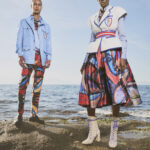The uniforms worn by US soldiers in World War II were designed for functionality and adaptability across diverse combat environments. Reflecting the evolving needs of warfare, the US Army issued different uniforms tailored to specific theaters of operation, notably the European and Pacific theaters. This article delves into the key uniform components worn by US soldiers, highlighting the variations and purpose behind each design.
European Theater Uniforms
The European Theater of Operations (ETO) presented US soldiers with a range of weather conditions, from cold winters to milder summers. Consequently, the uniforms for this theater prioritized warmth and protection against the elements.
Field Jackets
Two primary field jacket designs were issued: the M-1941 and the M-1943. The M-1943 field jacket, pictured below, became the standard issue, phasing out the earlier M-1941. Constructed from darker olive drab cotton poplin, the M-1943 was a single-breasted jacket featuring hidden buttons for improved snag resistance. Practical additions included two interior pockets, a detachable hood for varied weather protection, a cotton poplin liner for added warmth, and an internal synching tie for a more tailored fit and better heat retention. Crucially, the M-1943 offered enhanced wind and water resistance compared to its predecessor.
Alt text: A US soldier in World War II wearing the olive drab M-1943 field jacket, showcasing its design and fit.
The M-1941 field jacket, in contrast, was a windbreaker-style jacket made of lighter olive drab cotton poplin and lined with wool flannel for warmth. It featured a zipper closure, a roll collar, buttoned cuffs, and slanted front pockets. Its looser cut and more economical design led to its initial adoption as a replacement for the heavier service coat in field conditions.
Overcoats
For extreme cold weather, US soldiers were issued overcoats. These were crafted from a heavy wool melton fabric, known for its thick, dense weave and soft surface, providing substantial insulation against harsh winter conditions. (Overcoat not pictured).
Service Shirts
The service shirts were a button-up style garment made from olive drab wool flannel. Designed for both service wear and field use in milder conditions, these shirts featured two breast pockets and buttoned cuffs. The collar was specifically designed to accommodate a necktie, reflecting the formal uniform requirements when not in direct combat. (Service shirt not pictured).
P1937 Trousers
P1937 trousers were the standard issue wool trousers for service and field duty at the beginning of the war. Made from olive drab wool serge, these trousers featured a button fly, diagonal side pockets, a single rear pocket, belt loops, and internal suspender buttons. It’s important to note that breeches, at this time, were relegated only to mounted cavalry units, highlighting the shift away from traditional cavalry uniforms.
M1943 Trousers
Later in the war, the M-1943 trousers were introduced as an improvement. These trousers were made from a darker shade of olive drab cotton poplin and were unlined, making them suitable for layering. Adjustment tabs at the ankles and waist allowed for a more customized fit and facilitated wearing them over wool trousers in colder climates, increasing their versatility. (M-1943 Trousers not pictured).
M1938 Leggings
To protect the lower legs and ankles, particularly when wearing field service shoes, US soldiers utilized M1938 leggings. These leggings were made of khaki or olive drab cotton canvas and laced up the side, secured with hooks and eyelets. An adjustable strap went under the instep to keep them in place. However, with the introduction of combat boots in 1943, leggings became redundant for troops equipped with the new footwear. Similarly, puttees, which were spiral-wound cloth strips used for leg protection, were phased out as trench warfare was no longer a dominant feature of combat in WWII. (M-1938 Leggings and Puttees not pictured).
Pacific Theater Uniforms
The Pacific Theater of Operations (PTO) presented a drastically different environment compared to Europe, characterized by hot, humid jungle conditions and tropical island climates. Uniforms for the Pacific were designed for breathability and quick drying.
Jackets
Jackets in the Pacific theater were made from herringbone twill cotton. This material was chosen for its lighter weight and superior breathability compared to wool, as well as its faster drying time in humid conditions. The unlined, olive drab herringbone twill jacket was single-breasted with five buttons, two flap-secured breast pockets, and a roll collar designed to be worn open at the neck for ventilation. Although primarily intended for jungle and desert combat, some herringbone twill jackets with added chemical protection were also issued to troops involved in the Normandy Invasion, demonstrating the adaptability of certain uniform components.
Trousers
Like the jackets, trousers for the Pacific theater were also constructed from herringbone twill cotton in olive drab. These unlined trousers mirrored the jacket in material choice for the same reasons of breathability and quick drying. They featured a button fly, belt loops, internal suspender buttons, and importantly, large flap-secured cargo pockets on each side, providing ample storage for essential gear in the field.
In conclusion, the US soldier WWII uniform was not a single, monolithic design but rather a system of clothing adapted to the specific demands of different combat theaters. The European theater prioritized warmth and weather protection with wool and heavier fabrics, while the Pacific theater emphasized breathability and quick-drying materials like herringbone twill cotton. This adaptability highlights the logistical and design considerations involved in equipping a global army for diverse operational environments.

